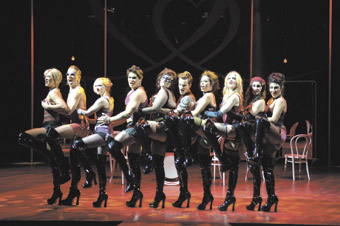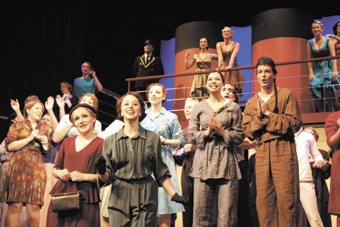precarious balance & extra-daily effort
jonathan bollen on theatre scholarship at risk

NIDA’s 2007 Graduation Production, Sweet Charity
photo James Morgan
NIDA’s 2007 Graduation Production, Sweet Charity
IN A DICTIONARY OF THEATRE ANTHROPOLOGY, EUGENIO BARBA OBSERVES THAT “THE CHARACTERISTIC MOST COMMON TO ACTORS AND DANCERS FROM DIFFERENT CULTURES AND TIMES IS THE ABANDONMENT OF DAILY BALANCE IN FAVOUR OF A ‘PRECARIOUS’ OR EXTRA-DAILY ‘BALANCE’.” HE ALSO NOTES THAT THIS “EXTRA-DAILY BALANCE DEMANDS A GREATER PHYSICAL EFFORT” THAN IS ORDINARILY REQUIRED OF OUR BODIES IN EVERYDAY LIFE.
Was there ever a time when the practice of theatre was not a precarious endeavour, a calculated risk, a gamble against the odds? Hasn’t theatre always been an enterprise at odds with the world, a rupture in the ordinary sequence of events, a hitch in the daily flow of time? And doesn’t theatre demand of those who perform and who attend something more than just the usual expenditure of energy, something in excess, something extravagant instead?
There is a risk in Barba’s description of performing for it may render ahistorical our culture’s disposition towards theatrical enterprise—as precarious as ever, a luxury, an unnecessary excess. I doubt there ever was a time when it was easy to make theatre, when resources flowed quite freely in response to offers, promises and requests. But some times do seem more difficult than others. At this time, it seems salutary to recall the qualities that Barba attributes to performers since precarious balance and extra-daily effort are certainly what is currently required to sustain theatre scholarship in our tertiary education institutions.
endangered undergrads
Most precarious, it seems, are theatre training programs for undergraduate students. Two universities—Griffith University on the Gold Coast and the University of Western Sydney—have recently proposed discontinuing their undergraduate programs in theatre and performance. These proposals do not countenance the resulting loss of opportunities for students to train in live performance. Nor do they consider the professional deficit that will be imposed upon the arts industry when academic staff are made redundant or redeployed. The rationale for discontinuation is driven in each case by an internal funding formula which does not value the modes of teaching and learning specific to the discipline.
Teaching students to become performing artists and theatre makers entails intensive, studio-based modes of learning with a high degree of interpersonal interaction between students and their teachers. The ideal class size for studio learning would be no more than 12. Yet not since the early 1990s have Australian universities afforded class sizes as low as this. Since then the ratio of students to staff has been steadily increasing: at latest count, in 2004, it was over 21.
With the number of students studying Drama at secondary school steadily increasing, a contraction in opportunities for undergraduate training in theatre and performance will put particular pressure on institutions which have focused on studio-based teaching. The traditionally small annual intake of students into the National Institute of Dramatic Arts, the Victorian College of the Arts, the Western Australian Academy of the Performing Arts, the Drama Centre at Flinders University and the Acting programs at the Queensland University of Technology and the University of Southern Queensland may be difficult to sustain.

The Arts Academy, University of Ballarat, Anything Goes
photo Ilana Rose
The Arts Academy, University of Ballarat, Anything Goes
solutions & consequences
Melbourne University is currently conducting a curriculum review in which Theatre Studies is asked to justify its offering in anticipation of the introduction of new generalist degrees in which subjects may be expected to enrol 250 students. Where student intakes don’t increase, departments may struggle to retain their staffing levels. As senior academics approach retirement, not all may be replaced. Another staffing challenge is the ‘brain-drain’ of Australian academics taking up attractive short- and long-term opportunities in universities overseas. Among such departures in recent times are Rachel Fensham, Helen Gilbert, Donald Pulford, Edward Scheer and Kerrie Schaeffer.
Under conditions of increasing student numbers and decreasing staff availability, studio-based teaching with intensive contact between staff and students may be deemed too readily ‘unsustainable’ and ‘uneconomic’ by unimaginative administrators. Sustaining viable theatre studies programs in Australian universities at this time is requiring extra-daily effort from academic staff, and university administrators who are prepared to get creative with the funding formulas.
postgrad artist refuge
The state of play for postgraduate research seems less precarious and more assured. Indeed, it appears that many postgraduates in theatre and performance have sought an institutional framework to stabilise their otherwise precarious existence as practising artists. At Extreme States, the annual conference of the Australasian Association for Theatre, Drama and Performance Studies held in Melbourne this July, postgraduates delivered more than one third of the presentations. Of the 31 postgraduates who presented, 24 indicated in their biographical notes substantial track records as practising artists—as performers, directors, dramaturgs, writers, producers and so on—including Adam Broinowski, Catherine Fargher, Julie-Anne Long, Alison Lyssa and David Williams.
This is one indication of significant changes in the pathways leading to postgraduate degrees in theatre and performance. As applicants for postgraduate admission, practising artists with track records of creative work may be outpacing traditional applicants—those bright yet less experienced bachelor degree students with first class honours results. The emergence of new practice-based research paradigms has enabled artists to attract postgraduate scholarships which offer a tax-free stipend of just under $20,000 per annum for three years. Postgraduate programs are providing supportive environments and financial sustenance for both established and emerging artists to engage in sustained periods of creative development, augmented here and there with bits of project funding from state and federal arts agencies. The easing of restrictions around access to arts funding for postgraduates and academics has been a welcome change.
the rise of the artist-scholar
Postgraduate artists becoming scholars at the vanguard of performance research are now moving on to academic posts. Also at the conference were Julie Robson, David Fenton and Leah Mercer who presented a joint panel reflecting on their experience in undertaking the first three doctorates by performance-led research at QUT. Their reflections emphasised the anxieties, insecurities and tensions inherent in “composing knowledge amidst the noisy endeavour of performance-led research.” Yet however precarious their research methods, these brave, new reflexive artist-scholars have now secured positions in the academy—Robson at Edith Cowan, Fenton at QUT and Mercer at Curtin.
rqf virtues tbc
Performance-led research ought to fare well under the Research Quality Framework, the Federal government’s new mechanism for distributing research funding to universities. Previously universities would report only the quantity of traditional research in the form of books, chapters, journal articles and conference proceedings. Under the new system, to be implemented in 2008, the emphasis is on the quality of research and its impact on end-users in industry and the community.
The quality and impact of research will be assessed by discipline-specific panels of academic peers and end-users. Panels will also determine what kinds of research may be reported for assessment. The creative arts will have an assessment panel of their own and creative works such as performances and exhibitions will be reported, alongside traditional forms of research, in the competition for research funds. In the future, universities may become more supportive of the creative research undertaken by scholars in theatre and performance—although, at this stage, the precise specifications are still emerging and the funding implications remain unclear.
on the record
Meanwhile the publication record of Australian researchers in theatre and performance is in good shape. Three academic journals publish current research. The long-running Australasian Drama Studies, now edited by Geoffrey Milne at La Trobe, has been joined by About Performance from Performance Studies at the University of Sydney, and Performance Paradigm edited by Peter Eckersall of Melbourne University and Edward Scheer of UNSW. And at the recent conference, four new books were launched including Joanne Tompkins’ Unsettling Space On Contemporary Australian Theatre and Helen Gilbert and Jacqueline Lo’s Performance and Cosmopolitics: On Cross-Cultural Performance in Australasia.
adapt, evolve or…
Like the challenge of sustaining viable programs for undergraduate students, the challenge of the Research Quality Framework will be an internal numbers game. The emphasis is on research strengths and concentrations, on winners and high-fliers. Small-scale theatre programs will forge alliances with the other creative arts or lose their practice-led approach and assets in mergers with the humanities.
RealTime issue #80 Aug-Sept 2007 pg. 15






